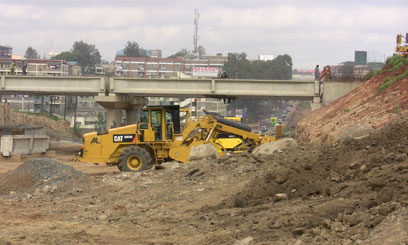NAIROBI, Kenya, Sep 2 – Almost two months into the new fiscal year, the Ministry of Roads has big plans to strengthen ties with Kenya’s regional neighbours.
With a Sh100.9 billion fund allocation, the Ministry of Roads received about 10 percent of this fiscal year’s budget, which the Ministry’s Permanent Secretary Michael Kamau said is geared towards regional connectivity.
Speaking to Capital Business, the PS said the theme to further integrate the region through infrastructure has been an ongoing theme for the Ministry since 2008 stemming from the Northern Corridor Transport Improvement Project.
“We must connect ourselves to our neighbors because they are the source of our business. Our road to Ethiopia 136 kilometers just opened the other day. Just see the impact it is having on Isiolo and Marsabit in terms of the potential growth,” he said.
With the East African road network accounting for 80 percent of the regional cargo, improving the Northern Corridor that runs from Mombasa to the Great Lakes is crucial in boosting trade and investment within the region.
Mr Kamau mentioned the improvement of the road from Athi River to Namanga and on to Arusha that accounts for Sh38 billion worth of trade between Kenya and Tanzania.
At about 90 percent complete, the Athi River-Namanga road stretching 132 km was contracted at the sum of Sh6.2 billion.
Already complete, the 100 km Emali-Loitoktok road was upgraded at a cost of Sh4.2 billion, which included an extension of 12km from Loitoktok to Kibauni at the Kenya-Tanzania border.
As the busiest road in the Northern Corridor, accounting for the highest volume of transit goods to Uganda, Rwanda, Burundi and Democratic Republic of Congo, the 60 km Eldoret-Webuye-Malaba road is still undergoing upgrades at a cost of Sh7.05 billion.
Over the last one year, Kenya exports to the East African Community partner States have grown by a surplus of Sh10 billion from a value of Sh79.7 billion to Sh90 billion, a major incentive to further develop infrastructure in the region.
The flow of goods from Kenya’s coastline has proven to be an issue, with the Port of Mombasa expected to surpass its full cargo holding capacity of 20 million tones, this year.
About 96 percent of cargo from the Mombasa port is transported by road, heavily overloading the Mombasa-Nairobi-Western economic corridor.
A major project that has been in the works for some time for the Roads Ministry in conjunction with the Ministry of Transportation is developing the Lamu Corridor.
Known as the Lamu Port-South Sudan-Ethiopia Transport Corridor or LAPSSET the project will serve as the entry point of goods for Ethiopia and South Sudan.
Now undergoing a detailed design and economic feasibility assessment, LAPSSET will open up towns in the Northern parts of Kenya that experts believe will contribute 85 percent of the country’s GDP and double the economy in the next 10 years.
The LAPSSET project will cost an estimated Sh1.8 trillion by 2020 and feature three resort cities, a capacity refinery of 120,000 barrels per day and international airport to be built in Lamu.
So far, three berths have been confirmed as the first part of construction for the Lamu Port, set to begin in the next three months.
To better streamline the transport system along the LAPSSET Corridor, a narrow band of about 200 km has been planned to accommodate the railway, pipeline, road and ICT cables.
“The total road will be about 10,700 km. Because this road is coming from Mombasa to join the road to Isiolo, we’ve started developing a connection to Ethiopia. What we need to develop is the connection from Isiolo going across to South Sudan,” said Mr Kamau.
Other South Sudan linkages include the Eldoret-Kitale-Nandapal road which is currently under design with studies being carried out over the next 18 months.
However, Mr Kamau said regional development does not mean the ministry is not minding internal roads.
Decongestion of Nairobi has been key for the Ministry, which involves completion of the Eastern and Northern bypasses and beginning construction on the Southern bypass.
The recent commencement of the Nairobi Western Ring Roads as well as the revival of the flyover plan, Mr Kamau said will tremendously ease the city center’s flow of traffic.
“As for the concession of the flyover which collapsed; we are back at it again. The World Bank has granted us money for the preparation of that project. We are working on it and we expect to go to the World Bank Board maybe in March next year to get the funds. So the preparation is now on full blast,” he said.
The plan is expected to have the flyover begin at Parkside Towers on Mombasa Road to James Gichuru Road, spanning approximately 11 kilometers.










































